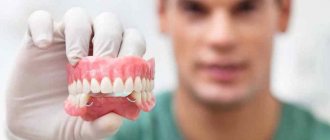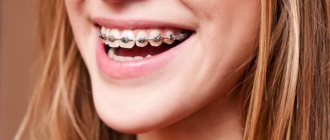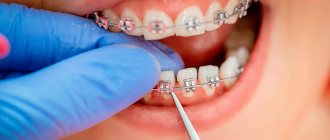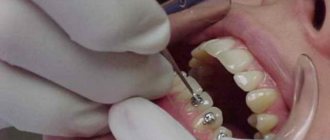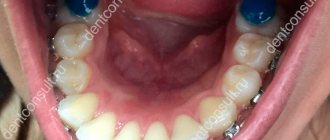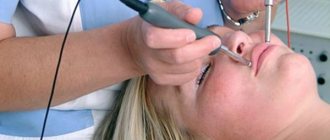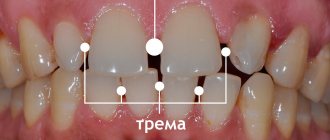Excursion into history | Ligature and self-ligating constructions | Biomechanics of tooth movement | System installation | Stages of treatment | Lingual and vestibular structures
Braces are locks fixed to the teeth with a groove and “wings”. The principle of operation of the system is the ability of the orthodontic arch to return to its original position. The straightening archwire puts pressure on the braces, causing the teeth to move. Fixed retainers and aligners stabilize the results obtained at the final stage of treatment.
The material was verified by Anna Rimkevich, senior product manager at Ormco Russia.
The basis of bite correction is the mechanism of action of weak forces and the movement of teeth in accordance with the bends and shape of the arch. The metal arch has “shape memory”: it straightens, pulls the braces along with it and moves the teeth in the desired direction. The formation and destruction of bone tissue is part of the natural process of tooth movement. The principle of operation of braces allows you to achieve the goal of orthodontic treatment - to create the best balance of occlusion, facial aesthetics and dentition.
Damon Clear with orthodontic arch
How do dental braces work?
Among the various devices for correcting the bite, braces are considered the most optimal and balanced. Externally, they are a complex structure, which is designed to move the dentition or individual units of teeth in the right direction without tilting the root.
The principle of operation of braces is distinguished by its functionality and the absence of analogues: the device not only moves the tooth, but can also rotate it.
Modern systems correct any malocclusion pathologies, eliminate diseases of the digestive tract, damage to soft tissues in the mouth and other health problems.
Both children and teenagers, as well as adults who have formed teeth, can wear braces.
The design features of the system provide for the presence of 2 components:
- Special arc.
- Fastening elements. They use brackets or brackets that are attached to the teeth.
The locks are fixed with an adhesive substance. Next, a metal arc is inserted into the groove of the brackets, which is held in place with rubber bands.
For the manufacture of modern braces, only high-quality materials are used, while their sizes remain miniature. In most cases, products are created from:
- Metal.
- Ceramics.
- Plastic.
- Sapphira.
Metal models are the most popular. Brackets and arches are made from steel, nickel and titanium alloys. Ceramic products are characterized by improved appearance, increased durability and safety of wearing. However, they are quite expensive, which is why they are not suitable for widespread use.
If you are interested in how dental braces work, you should pay attention to such details as orthodontic rings with soldered locks that are fixed to the last chewing teeth or to the wisdom tooth.
The presence of these devices is justified if it is not possible to install a bracket. Before installing the ring, the specialist secures the separators, which are needed for the temporary separation of bone units.
In addition, modern brace systems are equipped with the following details:
- Springs made of metal.
- Buttons.
- Metal ligature.
- Straps.
- Tubes for silicone arc.
After installing the structure, the ligaments that surround the tooth are subject to intense mechanical stress. To restore the usual balance, the body begins to maintain fiber volume. Therefore, in the place of sharp compression, the bones begin to dissolve, providing space between the teeth for the dental unit.
At another point where the fibers were stretched, another bone tissue is formed, which prevents the tooth from returning to its original incorrect location.
The key advantage of braces is their effectiveness. In this case, the positive effect will last a lifetime.
But we must not forget that the adjustment process takes quite a long time - in a month the tooth moves only 1 mm.
Types of braces according to installation site
Since you will have to wear braces for a long time, when choosing devices to straighten your bite and teeth, patients first of all pay attention to aesthetics. Quite often, the invisibility of the design when smiling is a compelling argument in favor of choosing a specific modification. That is why it will be useful for you to know that bracket systems are divided into two types according to the type of fixation:
- Vestibular
. Attached to the outside of the teeth. The most common brace systems that can correct even the most complex orthodontic defects. Since the plates are attached on the outer side, they will be visible when you smile. The materials used are metals, gold-containing alloys, ceramics and sapphire crystals. Locks or ligatures are used to secure the arch. If the result is in the first place for you, and not the invisibility of the braces, then choose vestibular models. - Lingual
. Attached to the inside of the teeth. They are used less frequently than vestibular ones, since they are more expensive and require highly qualified doctors who will install this brace system. Most often, before starting orthodontic treatment, additional diagnostics are required, including three-dimensional modeling of the predicted process of bite/teeth alignment.
The effectiveness of both types is approximately equal. The difference is that ligatures require greater precision in treatment planning and installation.
| Advantages | Flaws |
| Vestibular | |
|
|
| Lingual | |
|
|
Indications for using braces
The key indication for the use of braces is a pathological bite that cannot be corrected by other methods. Corrective systems are also indicated in the following cases:
- Dense cluster of teeth. When dental units are highly crowded, pathogenic microorganisms multiply in them. The tooth enamel is also subjected to heavy loads, and the teeth begin to wear out.
- Dystopia. The problem is characterized by the incorrect placement of 1 or more dental units.
- Problems with dental density. It is not uncommon for large gaps to form in the mouth, which can be explained by both genetics and tooth loss. The purpose of braces is to normalize density and combat discomfort and unaesthetic appearance of teeth.
The listed indications appear both in childhood and in adulthood. Due to the specific type of corrective structures, children often do not agree to have braces installed. But modern orthodontists can offer hidden variations of systems that do not spoil the aesthetics of the oral cavity and do not cause complexes.
Types of braces by material
The arch in the bracket system is a wire made of aluminum, silver or steel. But the type of design characterizes the material used to make the plates. The most popular braces are:
- Plastic
. The most fragile and short-lived in comparison with analogues. Indicated for correcting minor defects when treatment should take no more than two months. They cannot cope with severe malocclusion diseases. They require careful handling and cleaning, as excessive mechanical stress can lead to scratches, damage and complete breakdown. Most often used for orthodontic treatment of children. Not recommended for people involved in active sports. The plates of plastic brace systems are available in several options - white, transparent and colored (with a choice of colors). When cleaning, you must use only soft brushes and non-abrasive pastes. To avoid bad breath, it is recommended to use mouthwash after every meal. The choice of care products should be coordinated with the orthodontist. - Metal
. The most common braces. Such systems cope with even the most complex malocclusion pathologies. The use of these orthodontic devices guarantees the shortest possible time to achieve the desired effect. They are highly durable and do not stain when consuming food and drinks. The plaque can be easily removed from them. Since these braces are made of medical steel, allergies are rare. - Ceramic
. Modern dentistry can offer the production of ceramic braces to match the tooth enamel. If, at the same time, the arc is painted white, the structure will be noticeable only upon close examination. This option is ideal for those who plan to hide the fact of orthodontic treatment. Plaque can be easily removed from this type of braces. Due to the fact that ceramic models have a lower coefficient of friction (compared to metal ones), they last longer. Since ceramics is not the most durable material, bracket systems made from it are not prescribed in cases of complex occlusion pathologies. - Sapphire
. An ideal option for those who would like to effectively hide the use of braces. But, the transparency of the plates requires great care when cleaning, since any stuck food particles will be visible. To the traditional methods of oral care, it is worth adding treatment of teeth with an irrigator. They are used to eliminate mild and moderate pathologies, since artificial crystals are more fragile than metal or ceramics, and therefore cannot withstand heavy loads. - Titanium
. They can be classified as a type of metal braces. Compared to the steel structures described above, titanium structures are even more durable and lightweight. Having high biocompatibility (there is no nickel in the composition, as in metal analogues), titanium braces do not cause allergies and are indicated even for those patients who have problems with the gastrointestinal tract. - Combined
. They are a combination of several types of braces. Combining several materials in one design makes it possible to achieve a more aesthetically pleasing appearance of the systems, which is especially important for people who are concerned about their smile while wearing braces. Most often, more expensive ceramic/sapphire plates are placed in the smile area, and metal plates are placed on the chewing teeth. Although, the combinations can be very diverse.
In the process of choosing braces material, the orthodontist will definitely find out if there are any contraindications and, based on the collected anamnesis, will understand which design is optimally indicated in your case.
| Advantages | Flaws |
| Plastic | |
|
|
| Metal | |
|
|
| Ceramic | |
|
|
| Sapphire | |
|
|
| Titanium | |
|
|
| Combined | |
| They have advantages and disadvantages of those materials that are combined in the orthodontic apparatus | |
Diagnosis and preparation for treatment
Before starting the correction, the patient must undergo a comprehensive diagnosis and a number of preparatory measures. During the examination, the orthodontist must ask the patient a number of questions, examine the face and oral cavity, and also perform several tests. Additional procedures include examination with an X-ray machine, taking impressions and creating demonstration models of the jaws. Such measures make further treatment easier.
The preparatory stage consists of cleaning the dentition from all kinds of dirt, caries and food debris. The doctor also performs a fluoridation procedure on teeth.
Advantages and disadvantages of ligature systems
The operating principle of this type of braces makes it possible to achieve high efficiency in the correction process. However, their pros and cons should be considered. Here are the advantages of ligature bracket systems:
- Good results in bite correction.
- A wide range of pathologies that they can correct.
- Possibility to diversify the external design by changing the color of ligatures and locks.
- Budget cost.
The ligature system also has its own features:
- Frequent visits to the orthodontist to replace ligatures.
- Elements that are too hard may cause discomfort when worn.
- Light-colored rubber ligatures may become stained from contact with food.
Despite these disadvantages, ligature braces are used much more often to correct dental pathologies.
What affects the length of time you wear braces?
Correction of dental pathologies can take different periods of time. Orthodontists identify a number of factors that influence the process of wearing braces:
- Type and nature of the defect. Specialists prescribe installation of structures both for minor defects and for complex anomalies. Therefore, treatment periods vary greatly.
- Teeth crowding - high density may require the removal of 1 or more teeth for faster correction.
- Age indicators and surgical operations in the oral cavity.
You can determine the exact period from the specialist who is involved in the treatment.
How long to wear braces
Straightening teeth is a very painstaking process. Regardless of the type and material of the leveling structure, it will have to be worn for 1-1.5 years. In some cases, the duration of treatment is 2 years. If we take into account the need for subsequent use of retainers and mouth guards, the time period will increase even more.
No need to be upset. The jaws quickly get used to the metal arches, and therefore after just a few weeks of using them, a person practically stops noticing them. It is much wiser to spend one or two years on orthodontic therapy than to suffer for the rest of your life due to an incorrect bite.
How teeth move: changes by month
The stages of wearing braces are divided by month. During treatment, doctors change the location of the arch and carefully monitor the correctness of the bite correction. In most cases, normalization of the placement of roots and the angle of inclination of the teeth occurs after 7 months, and the first results are diagnosed already at the end of 2 months. However, they are often not visible to patients, causing people to doubt the effectiveness of the method.
To avoid problems, you should visit the clinic regularly. The specialist will be able to predict the timing of the movement of dental units and will inform you about all processes in the oral cavity.
In 1 month, the roots adapt to the foreign body and prepare for changes. In the early stages, it is difficult to notice visual changes, but when undergoing an X-ray examination, traces of successful correction are visible.
Starting from the first month and up to a year of therapy, the teeth are straightened. During this time, the specialist tightens the structure and restores the tension of the bracket.
Even at the beginning of the course, thin arcs are installed that do not have much impact on the enamel. Then the parts are changed to more durable ones. The effectiveness of therapy depends on this procedure, so doctors perform it once every 2-3 months.
The procedure must be performed by the trained orthodontist who placed your braces. It is not recommended to visit different clinics.
Deep and final correction occurs after aligning the dentition using special arches of increased rigidity. This process may be accompanied by painful sensations, but this is justified by a comprehensive correction of bite depth.
If after treatment the lower and upper jaws look asymmetrical, they are combined with preliminary tooth extraction.
Rules for treating adults with braces
During treatment, patients regularly visit the orthodontist: patients with ligature braces on average once a month, with non-ligature braces - once every one and a half to two months. During these visits (they are called activations), the doctor monitors how the treatment is progressing, changes the arches if necessary, and installs additional devices.
After installing braces and after activations, patients feel pain and discomfort for the first few days. During this time, you can take painkillers prescribed by your doctor.
There is a list of prohibited products for patients with braces. First of all, these are nuts, chips, crackers - anything hard that can damage the locks or wire.
After each meal, braces should be cleaned with special toothbrushes, brushes and an irrigator. It is important to clean the enamel around your braces. For these purposes, during treatment, patients also undergo professional oral hygiene.
How quickly does braces treatment take place?
Within 8 weeks from the installation of the corrective system, you can see how braces straighten your teeth. However, it is prohibited to suspend treatment during this period. The patient needs to continue visiting the orthodontist to correct the arch, which affects the dentition and makes changes to its structure.
The speed at which changes occur depends on a variety of factors, including:
- Condition of teeth.
- Staple type.
- Age characteristics of the patient.
You should also take into account the material used to make braces: metal products correct pathologies more quickly than models based on ceramics and sapphire.
In adult patients, the process drags on for up to 3 years, because as they grow older, bone tissue loses its elasticity and becomes dense. This prevents the teeth from moving freely.
Adults also need to wear the correction device longer than children in order to consolidate the positive effect. A longer duration of treatment is associated with a less intense occurrence of biological processes in the body.
Children's systems provide faster results. If you place them on sparse teeth, they will find their correct placement in the mouth within 12 months. This effect is due to the rapid passage of biological processes and good mobility of bone tissue.
If you look at the photographs of the oral cavity before and after therapy, you may not believe that there is only one patient in the photo. Thus, the correction completely changes the position of the jaw and gives the patients’ faces a different look. However, complete correction of pathological processes can take years and requires a lot of patience.
What is the cause of pathological mobility of teeth?
The well-known disease periodontitis is the main cause of this problem. This disease is inflammatory in nature and is characterized by destruction and reduction of tissue adjacent to the tooth. Dental deposits cause inflammation of the gums, which spread to the surrounding bone and ligaments. Inflamed tissue dissolves very quickly and is replaced by granulation tissue. And as a result of the fact that there is no more bone, the teeth acquire pathology in the form of mobility.
Pulling a tooth from the gum using systems
Pulling a tooth out of the gum is a complex process that is accompanied by a lot of time. The type of corrective systems is chosen by the patient, but presentable models made of ceramics and sapphire are in particular demand. People also prefer translucent locks. After choosing braces, the patient is prescribed surgical intervention with a tomographic examination and determination of the location of the pathological tooth, to which a small lock resembling a button with a chain is attached. The operation is not accompanied by pain, but during the first 10 days you need to monitor the condition of the wound and treat it. The pulling process also does not cause discomfort, but its duration reaches several months or years, depending on the complexity of the case.
Principle of operation
Immediately after braces are installed, they begin to put pressure on the teeth, gradually causing them to move. During this, the ligaments that are located around the unit are strained. As a result, the human body tries to compensate for the lack of tissue in the place where the fibers have been greatly stretched, and vice versa.
Where the fibers are strongly compressed, the tissues begin to gradually dissolve, freeing up space for the movement of adjacent teeth. The main advantage of using braces is that the results obtained, if all the specialist’s recommendations are followed, remain with the person for life.
The teeth begin to shift not because the brackets are attached to them, but due to the pressure of the metal power arc that connects them together. To maximize the effect of treatment, the arch should be changed periodically. This is due to the fact that over time the force of its pressure weakens. Also, at one of the regular preventive examinations, a specialist may come to the conclusion that it is necessary to install a more rigid arch.
Proper care will protect against loose teeth
One of the causes of loose teeth is periodontal tissue disease. To prevent their development, you need to properly care for your mouth while wearing an orthodontic appliance.
Proper care involves daily brushing of teeth with 3-4 types of brushes - regular, special orthodontic with a V-shaped bristle, single-tuft and brush-brush. These devices are used alternately, gradually removing all dirt and plaque. After brushing your teeth, you need to clean the interdental spaces using superfloss - a special orthodontic dental floss. At the final stage, the oral cavity and the braces system are cleaned using an irrigator. This device directs a powerful stream of water, which removes dirt from interdental spaces, periodontal pockets and other difficult areas. To care for braces, it is important to purchase irrigators with special orthodontic attachments.
Careful and regular oral care will prevent pathological loosening of teeth under braces and avoid their loss.
Why do teeth wobble under braces from an anatomical point of view?
Teeth are made up of two main parts—the dental crown (the visible part) and the root. They are connected to each other by a ligament supported by bone tissue. Under the pressure of braces, the tooth tilts, as a result of which the distance between the ligament and the dental crown changes: on the one hand it becomes larger, and on the other, on the contrary, smaller. Special cells - osteoblasts - begin to actively work and restore the missing bone tissue to create a new support for the tooth. Other cells—osteoclasts—perform the opposite job: they promote the resorption of bone tissue where the tooth needs to be moved.
In this way, the pinched connective ligament gradually straightens out, and the tooth can take its correct position. Such cycles of loss and growth of bone tissue are repeated many times during orthodontic correction, contributing to the gradual correction of the dentition.
But the speed of these processes is different: bone tissue is absorbed faster than it grows. This is the main reason why teeth become loose after braces start working.

